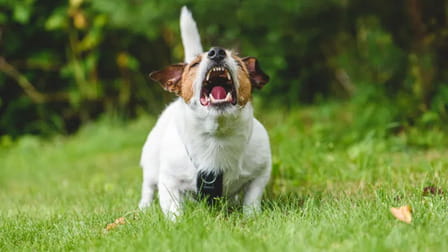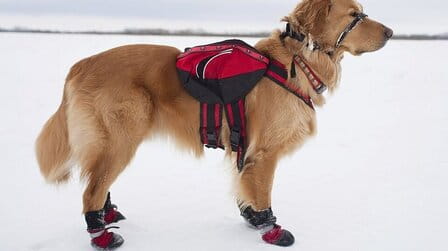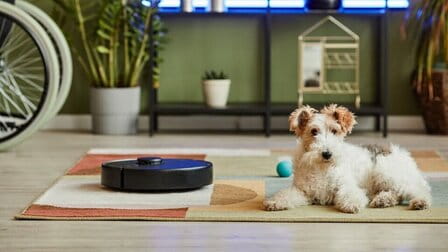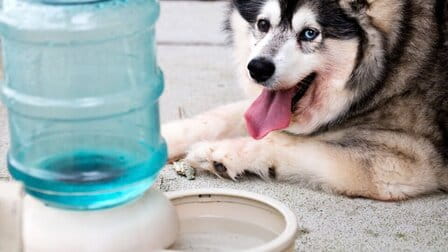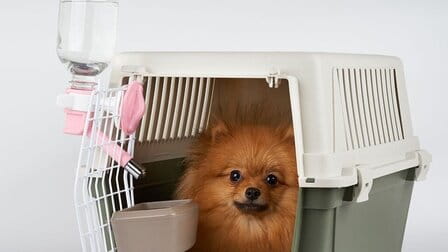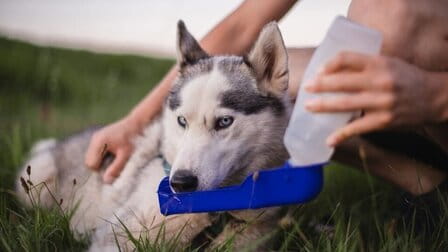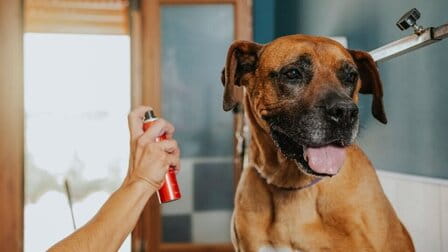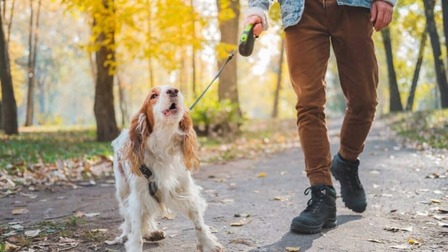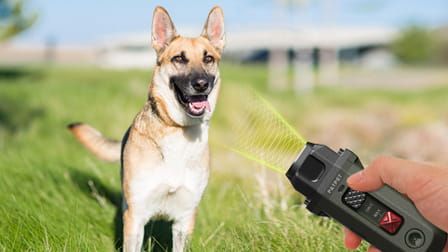Dogs have coexisted with humans for countless years and are considered man's best friend. These incredible creatures come in a variety of sizes, temperaments, and shapes depending on the species. The largest dog breeds in the world are usually calm, affectionate, easygoing and extremely devoted despite their large appearance. Throughout time, these companions have protected their owners' livestock, populations, and lands with extraordinary strength. The following are the different types of dogs big and their characteristics.
PitBull Dog – Warrior Dog
The Pitbull is a descendant of two breeds, the Terrier and the Bull, which first appeared in America in the early 19th century. They were originally bred to fight in brutal wars organized by humans, until 1935. When laws banning such wars were passed, they were tamed and became less barbaric. Because of this, it is called the Warrior Dog.
The pitbull is a medium-sized dog, 45 to 55 cm tall and 18 to 25 kg in weight, however they have stronger muscles than most other dog breeds of the same size. Pitbull has a slightly aggressive appearance, good physical strength and especially has bloodshot eyes and a wide forehead. It has strong bones, well-muscled muscles, and muscular front shoulders.
Normal Pitbulls are actually very docile, despite their intimidating appearance, unless they are scared or attacked. In addition to being a devoted and affectionate animal, the breed's fighting prowess makes it ideal for house guard.
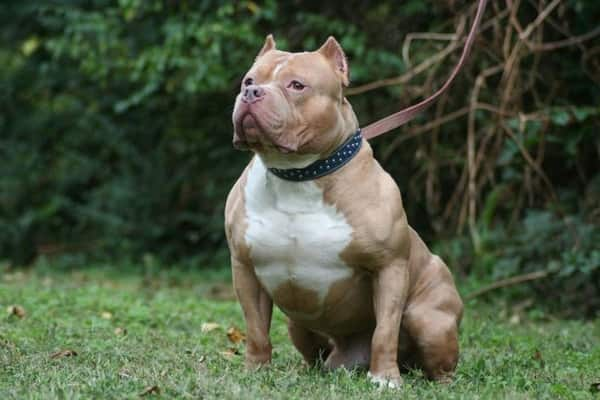
Bullmastiff - Bull Mastiff
Originating in England in the 1860s, the Bullmastiff is a cross between a Mastiff and a Bulldog. The Bullmastiff, which continues to be popularly bred today, was certified purebred by the British Kennel Club in 1924.
The Bullmastiff, a cross between a Bulldog and a Mastiff, combines greatness and agility, elegance and power. Adult bullmastiffs are usually 61 to 69 cm tall and weigh 45 to 60 kg. Although their backs and legs are usually short, their muscles are well developed.
The nose with the lower jaw protruding quite fiercely, the face is rectangular with a rather large black nose. However, their faces are always the same. The ears are always V-shaped and drop down. They have a dense coat, often yellow, reddish brown or mottled.

Labrador Dog
Labrador dog breeds originated in Canada, owners often accompany them when hunting because they can sniff and catch prey. Since its introduction to England in 1800, people have always chosen them as pets.
An adult Labrador has a long body, 50–60 cm tall, 25–35 kg weight, strong bones and muscles. They have huge heads, long, fairly square noses, and strong, pointed teeth. They have very large nostrils, usually chocolate or black, giving them a keen sense of smell that allows them to detect prey hundreds of meters away.
Labrador dogs are affectionate, joyful canines who enjoy being around people, especially kids. They are a highly clever and obedient species, making training them quite simple. Additionally, they are a very loyal and trustworthy animal.

Alaska dog
The wild wolf breed was domesticated by the Malamute tribe as a pet, the ancestor of the Alaskan Malamute dog breed. They were once bred with other dogs to develop large bodies for the purpose of pulling sleds. Later, Alaskans raised and trained them as domestic pets.
Their usual weight is between 45 and 50 kg, and their height ranges from 65 to 70 cm. This dog's massive skeleton, strong leg joints, and well-balanced body are the results of its long history of sled work training. Alaskan dogs, like Husky dogs, have double fur to withstand the cold. Their big, distinctive nostrils have a charming, light pink center that makes them stand out from other animals.
Alaskans used to be quite clever and aggressive, but domestication has made them more docile, kind, and peaceful. They are incredibly devoted to their owners in particular and show great obedience.

Husky dog
Relatives to the Husky are the Samoyed and the Alaskan Malamute, two sled dogs that originated in northeastern Siberia in Russia. Due to their extreme speed and power, they were shipped to Alaska in the United States in 1908 for towing service. Nowadays, many people decide to keep them as pets.
Husky dogs are about 53–58 cm tall and weigh 20–27 kg. Their physique is elongated, the muscles especially in the legs are strongly developed. The distinguishing feature of this breed is its thick double coat that allows them to move more freely by reducing air resistance. In addition, the Husky is the only dog breed with almond-shaped eyes.
Husky is a very submissive, intelligent and agile animal. They are very affectionate and enjoy spending time with children, so people often see them as family members.

Beige - German Hound
Max Von Stephanitz, a captain in the German army, started breeding German Becgie dogs in 1899. They were trained by the police and military to perform tasks such as guarding, mail delivery, rescue and security. guard. After the war, everyone kept the Becgie dog as the favorite pet it is today.
Depending on the young, an adult German Hound can grow up to 60–65 cm tall and weigh 30–40 kg. They have strong, muscular bodies with toned muscles, deep abdominals and strong pectoral muscles. They can move more flexibly thanks to their elongated legs.
One of the most intellectual dog breeds is the German Becgie. They are exceptionally docile species, accepting only one person as their master and always obeying their commands. Becgie is very affectionate with family members. They only become hostile when you purposefully provoke them or trespass into the space they are trying to defend.

Doberman - Watchdog
The Doberman dog was developed by German producer Louis Dobermann, but Otto Goeller gave it its name, made the breed's selections, and enhanced its quality by mating it with numerous other breeds, to develop the type of dog we breed and keep today.
The Doberman dog has a unique body with a huge chest, a straight back, and a small belly. They can move rapidly and flexibly due to their long legs & strong thighs and hip muscles. Typically, their heads are tiny, with an extended snout and powerful, pointed teeth. The Doberman dog's tail is the beauty standard for this breed, and although it is actually quite long, it is clipped at the age of a couple days.
Since Doberman dogs have indeed been trained for guard duty for decades, they have the skills needed for the job, including sensitivity, strength, and endurance. They are also incredibly gentle, creative, and lovable canines who are incredibly dedicated, loyal, and loving. When rearing Dobermans, you should start early and educate them so they become submissive and simple to handle.

Great Pyrenees dog
Great Pyrenees were originally bred to raise livestock, protecting farms and livestock from wild animals. However, the Great Pyrenees are the ideal family dog thanks to their laid-back, mellow personalities.
Great Pyrenees grow from 65 to 74 cm for female dogs and 70 to 82 cm for male dogs of average height. Great Pyrenees males weigh about 50 to 54 kg, while females weigh between 36 and 41 kg.
The largest dog breed in the world has a double coat that protects against the cold. The inner coat is soft and thick, while the outer coat is thick, coarse and can be flat or slightly curly. Pure pure white with light brown and gray spots that make up the coat.
They have particularly keen senses that enable them to quickly identify potential threats. This breed loves spending time with family and is extremely loving and devoted. They love to play with children and other pets in the house.

Conclusion
Although the large breed has some quirks, with proper care and training, they make excellent friends and family protectors. Because large dogs in general tend to be calmer and more laid-back, they get along well with children and other family members, and are friendly and affectionate with them. It's great to have this giant dog in your home. However, you must also ensure that you and your family are safe by receiving thorough instructions on how to care for and control these breeds.

